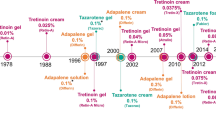Abstract
The topical retinoid tretinoin and topical retinoid analogues such as adapalene and tazarotene help normalize hyperkeratinization in acne vulgaris and have demonstrated significant anti-inflammatory effects in experimental trials. Inhibition of various immune factors, including the activity of leukocytes, the release of proinflammatory cytokines and other mediators, and the expression of transcription factors and toll receptors involved in immunomodulation, has emerged in both in vitro studies and in vivo animal experiments. These multiple mechanisms of action should encourage clinicians to consider these agents in the first-line management of inflammatory acne lesions.
Similar content being viewed by others
References
Johnson BA, Nunley JR. Topical therapy for acne vulgaris. How do you choose the best drug for each patient?Postgrad Med. 2000;107:69–80.
Shalita A. The integral role of topical and oral retinoids in the early treatment of acne.J Eur Acad Dermatol Venereol. 2001;15(suppl 3):43–49.
Webster GF. Inflammation in acne vulgaris.J Am Acad Dermatol. 1995;33:247–253.
Norris JF, Cunliffe WJ. A histological and immunocytochemical study of early acne lesions.Br J Dermatol. 1988;118:651–659.
Ingham E, Walters CE, Eady EA, Cove JH, Kearney JN, Cunliffe WJ. Inflammation in acne vulgaris: failure of skin micro-organisms to modulate keratinocyte interleukin 1α production in vitro.Dermatology. 1998;196:86–88.
Stingl G, Maurer D, Hauser C, Wolff K. The epidermis: an immunologic microenvironment. In: Freedberg IM, Eisen AZ, Wolff K, et al, eds.Fitzpatrick’s Dermatology in General Medicine. 5th ed. New York, NY: McGraw-Hill; 1999:343–370.
Lee WL, Shalita AR, Suntharalingam K, Fikrig SM. Neutrophil chemotaxis byPropionibacterium acnes lipase and its inhibition.Infect Immun. 1982;35:71–78.
Scott DG, Cunliffe WJ, Gowland G. Activation of complement—a mechanism for the inflammation in acne.Br J Dermatol. 1979;101:315–320.
Brostoff J, Scadding GK, Male DK, Roitt IM.Clinical Immunology. New York, NY: Gower Medical; 1992.
Strauss JS, Thiboutot DM. Diseases of the sebaceous glands. In: Freedberg IM, Eisen AZ, Wolff K, et al, eds.Fitzpatrick’s Dermatology in General Medicine. 5th ed. New York, NY: McGraw-Hill; 1999:769–784.
Czernielewski J, Michel S, Bouclier M, Baker M, Hensby C. Adapalene biochemistry and the evolution of a new topical retinoid for treatment of acne.J Eur Acad Dermatol Venereol. 2001; 15(suppl 3):5–12.
Wauben-Penris PJJ, Cerneus DP, van den Hoven WE, Leuven PJMJ, den Brok JHAM, Hall DWR. Immunomodulatory effects of tretinoin in combination with clindamycin.J Eur Acad Dermatol Venereol. 1998;11(suppl 1):S2-S7.
Oh G-S, Pae H-O, Seo W-G, et al. Inhibitory effect of retinoic acid on expression of inducible nitric oxide synthase gene in L929 cells.Immunopharmacol Immunotoxicol. 2001;23:335–342.
Duvic M. Pharmacologic profile of tazarotene.Cutis. 1998;61(2 suppl):22–26.
Hensby C, Cavey D, Bouclier M, et al. The in vivo and in vitro anti-inflammatory activity of CD271: a new retinoid-like modulator of cell differentiation.Agents Actions. 1990;29:56–58.
Shroot B, Michel S. Pharmacology and chemistry of adapalene.J Am Acad Dermatol. 1997; 36(suppl 1):S96-S103.
Data on file. Galderma, LP, Fort Worth, Texas.
Aderem A, Ulevitch RJ. Toll-like receptors in the induction of the innate immune response.Nature. 2000;406:782–787.
Bouclier M, Luginbuhl B, Shroot B, Hensby CN. Arachidonic acid induced ear oedema in four strains of rats and mice: a comparative study of anti-inflammatory drugs.Agents Actions. 1990; 29:62–64.
Wolf JE. An update of recent clinical trials examining adapalene and acne.J Eur Acad Dermatol Venereol. 2001;15(suppl 3):23–29.
Author information
Authors and Affiliations
Rights and permissions
About this article
Cite this article
Wolf, J.E. Potential anti-inflammatory effects of topical retinoids and retinoid analogues. Adv Therapy 19, 109–118 (2002). https://doi.org/10.1007/BF02850266
Issue Date:
DOI: https://doi.org/10.1007/BF02850266




